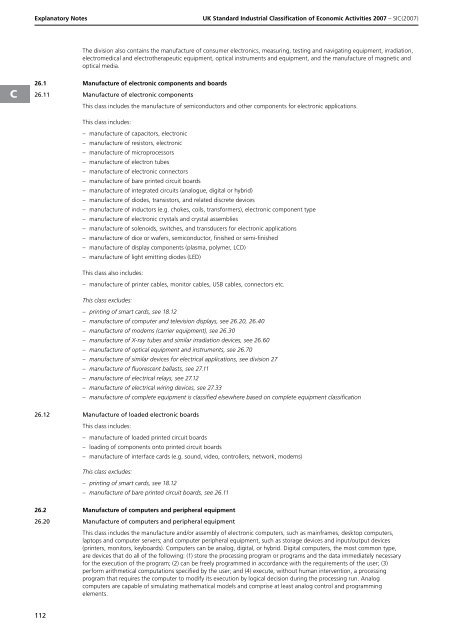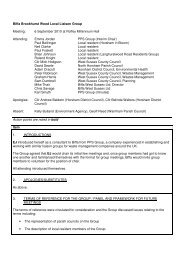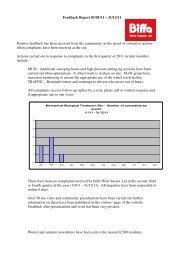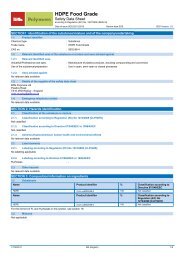detailed explanation for each SIC code - Biffa
detailed explanation for each SIC code - Biffa
detailed explanation for each SIC code - Biffa
Create successful ePaper yourself
Turn your PDF publications into a flip-book with our unique Google optimized e-Paper software.
Explanatory Notes<br />
UK Standard Industrial Classification of Economic Activities 2007 – <strong>SIC</strong>(2007)<br />
The division also contains the manufacture of consumer electronics, measuring, testing and navigating equipment, irradiation,<br />
electromedical and electrotherapeutic equipment, optical instruments and equipment, and the manufacture of magnetic and<br />
optical media.<br />
C<br />
26.1 Manufacture of electronic components and boards<br />
26.11 Manufacture of electronic components<br />
This class includes the manufacture of semiconductors and other components <strong>for</strong> electronic applications.<br />
This class includes:<br />
–<br />
–<br />
–<br />
–<br />
–<br />
–<br />
–<br />
–<br />
–<br />
–<br />
–<br />
–<br />
–<br />
–<br />
manufacture of capacitors, electronic<br />
manufacture of resistors, electronic<br />
manufacture of microprocessors<br />
manufacture of electron tubes<br />
manufacture of electronic connectors<br />
manufacture of bare printed circuit boards<br />
manufacture of integrated circuits (analogue, digital or hybrid)<br />
manufacture of diodes, transistors, and related discrete devices<br />
manufacture of inductors (e.g. chokes, coils, trans<strong>for</strong>mers), electronic component type<br />
manufacture of electronic crystals and crystal assemblies<br />
manufacture of solenoids, switches, and transducers <strong>for</strong> electronic applications<br />
manufacture of dice or wafers, semiconductor, finished or semi-finished<br />
manufacture of display components (plasma, polymer, LCD)<br />
manufacture of light emitting diodes (LED)<br />
This class also includes:<br />
–<br />
manufacture of printer cables, monitor cables, USB cables, connectors etc.<br />
This class excludes:<br />
–<br />
–<br />
–<br />
–<br />
–<br />
–<br />
–<br />
–<br />
–<br />
–<br />
printing of smart cards, see 18.12<br />
manufacture of computer and television displays, see 26.20, 26.40<br />
manufacture of modems (carrier equipment), see 26.30<br />
manufacture of X-ray tubes and similar irradiation devices, see 26.60<br />
manufacture of optical equipment and instruments, see 26.70<br />
manufacture of similar devices <strong>for</strong> electrical applications, see division 27<br />
manufacture of fluorescent ballasts, see 27.11<br />
manufacture of electrical relays, see 27.12<br />
manufacture of electrical wiring devices, see 27.33<br />
manufacture of complete equipment is classified elsewhere based on complete equipment classification<br />
26.12 Manufacture of loaded electronic boards<br />
This class includes:<br />
–<br />
–<br />
–<br />
manufacture of loaded printed circuit boards<br />
loading of components onto printed circuit boards<br />
manufacture of interface cards (e.g. sound, video, controllers, network, modems)<br />
This class excludes:<br />
–<br />
–<br />
printing of smart cards, see 18.12<br />
manufacture of bare printed circuit boards, see 26.11<br />
26.2 Manufacture of computers and peripheral equipment<br />
26.20 Manufacture of computers and peripheral equipment<br />
This class includes the manufacture and/or assembly of electronic computers, such as mainframes, desktop computers,<br />
laptops and computer servers; and computer peripheral equipment, such as storage devices and input/output devices<br />
(printers, monitors, keyboards). Computers can be analog, digital, or hybrid. Digital computers, the most common type,<br />
are devices that do all of the following: (1) store the processing program or programs and the data immediately necessary<br />
<strong>for</strong> the execution of the program; (2) can be freely programmed in accordance with the requirements of the user; (3)<br />
per<strong>for</strong>m arithmetical computations specified by the user; and (4) execute, without human intervention, a processing<br />
program that requires the computer to modify its execution by logical decision during the processing run. Analog<br />
computers are capable of simulating mathematical models and comprise at least analog control and programming<br />
elements.<br />
112
















